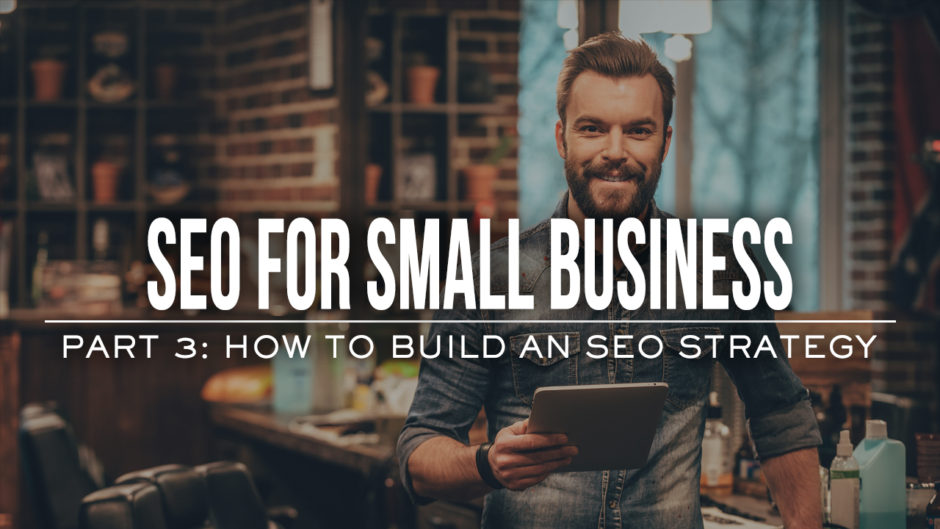
In parts 1 and 2 of our Small Business SEO series I explained what SEO is , why it is important to your business and how Google ranks content – and today I’m going to talk about how to build and SEO Strategy.
To help optimize a website for improved ranking, we need to address 3 factors:
 I want to start out by talking about the website structure and build – and I want to mention that if your website was poorly built, you’re fighting an uphill battle. This is why we rarely implement SEO strategies for clients whose website we audited and found to be inadequate. It’s like using band-aids when you need a cast, no amount of work will get you optimal results.
I want to start out by talking about the website structure and build – and I want to mention that if your website was poorly built, you’re fighting an uphill battle. This is why we rarely implement SEO strategies for clients whose website we audited and found to be inadequate. It’s like using band-aids when you need a cast, no amount of work will get you optimal results.
A series of things need to happen for your website to appear in search engine result pages (SERPS).
This last part is what allows the algorithm to consider including your web pages in SERPS.
It’s important to understand that Google does not see your web pages the same way you do. When you visit your website you see a complete layout containing images, colors, graphics, formatted text and links – all Google sees is text. And because of the way a search engine sees a website, any page elements that it is unable to render as text are essentially hidden. It’s very important to understand this because while you may look at a website and think everything looks fine, a search engine might be unable to interpret the content if it’s implemented incorrectly. This brings us to to on-page optimization which is designed to allow Google to correctly scan and index your web pages.
On-page, also called on-site, optimization consists of:
 We’ll start with website navigation. When a search scans, or crawls your website, it uses links, just like you do. The crawler, or spider, begins with a web page and then follows every link it can find and continues to analyze and index content until it can’t find any new pages. And if you remember what I said earlier, the search engine only sees text, so it’s critical that the main navigation elements on your website is constructed using text and not images.
We’ll start with website navigation. When a search scans, or crawls your website, it uses links, just like you do. The crawler, or spider, begins with a web page and then follows every link it can find and continues to analyze and index content until it can’t find any new pages. And if you remember what I said earlier, the search engine only sees text, so it’s critical that the main navigation elements on your website is constructed using text and not images.
Next I want to talk about links. You may not link to every page from your main or footer navigation, some sub-pages or blog posts may only be linked to from other main pages on the website. Again, it’s imperative that the links are text links and not images – it’s also a good idea to make sure every page has a link to it from another page on the website. It’s also important that you remove or correct any broken or dead links that may prevent search engines from indexing your content and frustrate your visitors.
Moving on, search engines have to crawl 100’s of millions of websites and then have to try to understand the structure and the context of each one. To make this easier, web developers can implement a logical, and simple-to-follow URL structure. This organizes the website, helps the search engines learn about the relationship between the various pages and allows them to quickly understand the content.
The next on-page optimization factor I want to talk about is page speed. Search engines want to provide a positive user experience, and that includes speed. In some part, search engines look at the page speed, or how long it takes a page to load to help rank pages. This is based on the assumption that, all things being equal, users would rather wait the least amount of time for the content to appear. Different elements, like how code is written, how libraries are linked to and optimized image sizes can contribute to load times.
Next let’s talk about sitemaps and robots.txt files. A sitemap is a file, or series of files that list the URL of every page on your website. This isn’t necessarily a file that your visitors interact with, but it can be submitted to search engines to help them locate pages and identify which ones they should crawl and index. Sitemaps can also tell a search engine how often to check each page for potential updates. A robots.txt file, which might sound intimidating, simply text a search engine what content it doesn’t need to crawl and index – for example, you may have a terms of use page that you don’t need to have indexed.
The last on-page optimization element I want to mention is duplicate content. Remember that its core, the search engine is trying to provide the user with relevant and useful results. If your website contains multiple pages with duplicate content, it can case the search engine to consider this content to be spam and can negatively impact your website’s ranking. Think of it this way, if you’re searching for chicken noodle soup recipes, would you want to go to a website that lists the same exact recipe on 10 different pages? Or would you rather go to a website that has 10 different recipes?
 Now let’s move to the second SEO strategy factor – which is proper content. When a user visits Google and types in a search, they are looking for information which could be a product, a service, an answer – regardless, this information exists in the form of content.What does this content look like? That depends. Even within a single website tt could be a page describing a particular service or product, it could be a blog post detailing a specific use case or benefit, it could be a video demonstrating how a product is used, it can be a client testimonial sharing their personal experience; and of course there are other formats.
Now let’s move to the second SEO strategy factor – which is proper content. When a user visits Google and types in a search, they are looking for information which could be a product, a service, an answer – regardless, this information exists in the form of content.What does this content look like? That depends. Even within a single website tt could be a page describing a particular service or product, it could be a blog post detailing a specific use case or benefit, it could be a video demonstrating how a product is used, it can be a client testimonial sharing their personal experience; and of course there are other formats.
But regardless of the format, it’s all considered content – and search engines love content, and more content helps you improve your visibility and ranking. And it’s simple to see why. The more relevant content a website has on a particular topic, the more likely it is that the user will find what they are looking for. The search engine crawls every page it finds website, it looks at things like the amount of content the page contains, how it’s structured, which keywords are being used and in what ratio and placement, and it uses its algorithm to determine how relevant this page is to the user’s search query.
Ok, so which keywords should you use? How many of them should you use? How often, and where? The first step is keyword research. The goal is to get as many visitors to your website as possible right? Wrong – the goal is to get as many visitors who are looking for what you offer. I’ll get to this more in the next video, but think of it this way, would you rather get 1000 random people to your website and convert 5 of them? Or get 50 qualified visitors and convert 20 of them?
But how do you get qualified visitors? It begins with working to have your website rank specifically for keywords these potential visitors use when searching. You have to get inside the mind of your client and understand what THEY will type when they are looking for what you offer, not what you you would type. Start out by identifying terms that are relevant to your business. These could be the actual product or service that you offer, for example “branding company in cleveland” or “Cleveland web design company”.
Next, take this preliminary list and go through a more detailed process to identify any related or more targeted keywords and key phrases. Now that you identified a list of keywords, create a hierarchy base on business priorities and use that as a guideline when creating and optimizing content.
Remember that in order for Google to rank your page well, it must first understand what you page is about.
To help Google with this process, you want to use your primary keyword in a few places.
Remember that the search engine is attempting to identify a level of authority and credibility for each web page, do here is what we can do to help.
 Ok, so we talked about website structure, having the proper content and we’re moving on to the third factor which is backlinks. Backlinks are essentially the opposite of external links. Rather than you linking to other websites, backlinks are links from other websites to yours. The reason why backlinks are important to search engines is that they assume that if other sources have chosen to link to your content, it’s link because that content was proven to be of value.
Ok, so we talked about website structure, having the proper content and we’re moving on to the third factor which is backlinks. Backlinks are essentially the opposite of external links. Rather than you linking to other websites, backlinks are links from other websites to yours. The reason why backlinks are important to search engines is that they assume that if other sources have chosen to link to your content, it’s link because that content was proven to be of value.
I do want to mention that all backlinks are created equal, and the search engines consider the source. That means that having a link to your website from Forbes.com will carry more weight than having a link from an obscure website with very few visitors.
If you remember in episode 2 of this series, we mentioned Black Hat SEO. One example is link farms, or networks of websites built specifically to be used as backlink sources to try and trick the search engine into believing that a website is popular. Not only will this strategy not help you in the long run, it may actually penalize your website.
In order to determine which links are qualified and which aren’t, the search engines look at:
Now that we know why backlinks are important and what we shouldn’t do, how do we go about acquiring real, trustworthy backlinks.
This is probably the most challenging aspect of SEO, and at the core of this strategy is creating valuable content.:
If you still need ideas, you can always conduct an analysis of what your competitors or best-in-class websites do so that you can mirror those efforts.
 Alright, so this concludes part 3 of our Small Business Website SEO series, in part 4 we’ll cover how to track and measure SEO results. I really hope I was able to give you a good overview of how to build an SEO Strategy for your small business. If I did, please let me know by giving this video thumbs up, tweet it, share it, and if you haven’t yet, join the community by hitting the subscribe and notification buttons. If you have any questions about this video, please put them in the comments section below and I’ll do my best to help you.
Alright, so this concludes part 3 of our Small Business Website SEO series, in part 4 we’ll cover how to track and measure SEO results. I really hope I was able to give you a good overview of how to build an SEO Strategy for your small business. If I did, please let me know by giving this video thumbs up, tweet it, share it, and if you haven’t yet, join the community by hitting the subscribe and notification buttons. If you have any questions about this video, please put them in the comments section below and I’ll do my best to help you.
For more branding, marketing, web design and seo tips and tutorials, you can find us on Instagram, Twitter and Facebook. Good luck and see you soon.